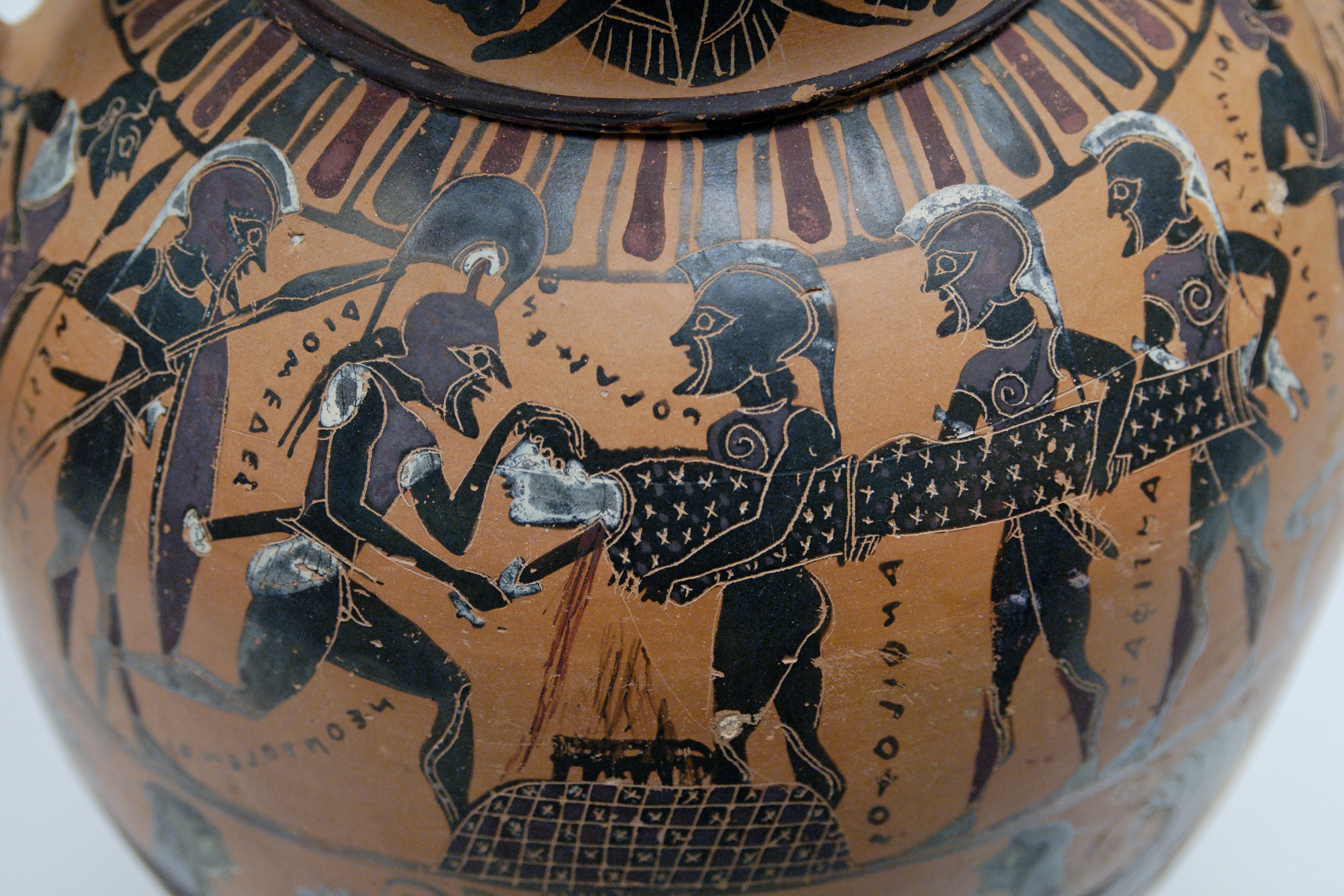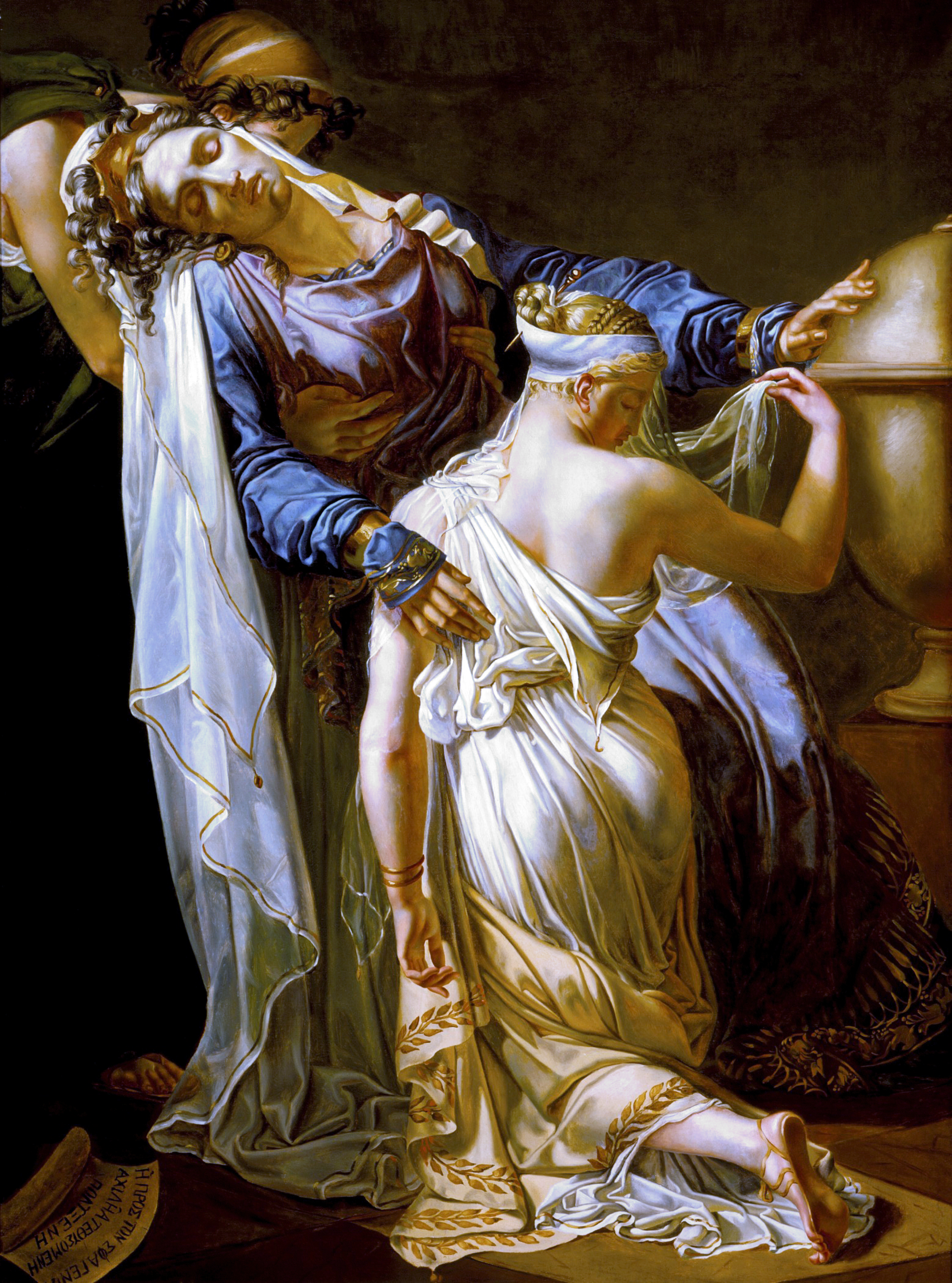|
Returns From Troy
The Returns from Troy are the stories of how the Greek leaders returned after their victory in the Trojan War. Many Achaean heroes did not return to their homes, but died or founded colonies outside the Greek mainland. The most famous returns are those of Odysseus, whose wanderings are narrated in the ''Odyssey'', and Agamemnon, whose murder at the hands of his wife Clytemnestra was portrayed in Greek tragedy. The sack of Troy The Achaeans entered the city using the Trojan Horse and slew the slumbering population. Priam and his surviving sons and grandsons were killed. Glaucus, son of Antenor, who had earlier offered hospitality to the Achaean embassy that asked the return of Helen of Troy and had advocated so was spared, along with his family by Menelaus and Odysseus. Aeneas took his father on his back and fled. He was left alone because of his piety. The city was razed and the temples were destroyed. Of the women of the royal family, Locrian Ajax violated Cassandra on Athena ... [...More Info...] [...Related Items...] OR: [Wikipedia] [Google] [Baidu] |
Trojan War
In Greek mythology, the Trojan War was waged against the city of Troy by the Achaeans (Greeks) after Paris of Troy took Helen from her husband Menelaus, king of Sparta. The war is one of the most important events in Greek mythology and has been narrated through many works of Greek literature, most notably Homer's ''Iliad''. The core of the ''Iliad'' (Books II – XXIII) describes a period of four days and two nights in the tenth year of the decade-long siege of Troy; the '' Odyssey'' describes the journey home of Odysseus, one of the war's heroes. Other parts of the war are described in a cycle of epic poems, which have survived through fragments. Episodes from the war provided material for Greek tragedy and other works of Greek literature, and for Roman poets including Virgil and Ovid. The ancient Greeks believed that Troy was located near the Dardanelles and that the Trojan War was a historical event of the 13th or 12th century BC, but by the mid-19th century AD, both ... [...More Info...] [...Related Items...] OR: [Wikipedia] [Google] [Baidu] |
Athena
Athena or Athene, often given the epithet Pallas, is an ancient Greek goddess associated with wisdom, warfare, and handicraft who was later syncretized with the Roman goddess Minerva. Athena was regarded as the patron and protectress of various cities across Greece, particularly the city of Athens, from which she most likely received her name. The Parthenon on the Acropolis of Athens is dedicated to her. Her major symbols include owls, olive trees, snakes, and the Gorgoneion. In art, she is generally depicted wearing a helmet and holding a spear. From her origin as an Aegean palace goddess, Athena was closely associated with the city. She was known as ''Polias'' and ''Poliouchos'' (both derived from '' polis'', meaning "city-state"), and her temples were usually located atop the fortified acropolis in the central part of the city. The Parthenon on the Athenian Acropolis is dedicated to her, along with numerous other temples and monuments. As the patron of craft an ... [...More Info...] [...Related Items...] OR: [Wikipedia] [Google] [Baidu] |
Euboea
Evia (, ; el, Εύβοια ; grc, Εὔβοια ) or Euboia (, ) is the second-largest Greek island in area and population, after Crete. It is separated from Boeotia in mainland Greece by the narrow Euripus Strait (only at its narrowest point). In general outline it is a long and narrow island; it is about long, and varies in breadth from to . Its geographic orientation is from northwest to southeast, and it is traversed throughout its length by a mountain range, which forms part of the chain that bounds Thessaly on the east, and is continued south of Euboia in the lofty islands of Andros, Tinos and Mykonos. It forms most of the regional unit of Euboea, which also includes Skyros and a small area of the Greek mainland. Name Like most of the Greek islands, Euboea was known by other names in antiquity, such as ''Macris'' (Μάκρις) and ''Doliche'' (Δολίχη) from its elongated shape, or ''Ellopia'', ''Aonia'' and ''Abantis'' from the tribes inhabiting it. Its ... [...More Info...] [...Related Items...] OR: [Wikipedia] [Google] [Baidu] |
Macistus
In Greek mythology, Macistus or Makistos (Ancient Greek: Μάκιστος means 'tallest' or 'greatest) may refer to the following person and surname: * Macistus, a Boeotian prince as the son of King Athamas probably by the cloud-nymph Nephele, thus the brother of Phrixus and Helle. From Macistus, the town of Macistus in Triphylia was believed to have derived its name. * Makistios, an epithet of Heracles, who had a temple in the neighbourhood of the town of Macistus in Triphylia, Elis (Peloponnese). Strabo8.3.21 p. 348: '' — In the intervening space are both the temple of the Macistian Heracles and the Acidon River.''. See also *Mecisteus Notes References *Stephanus of Byzantium Stephanus or Stephan of Byzantium ( la, Stephanus Byzantinus; grc-gre, Στέφανος Βυζάντιος, ''Stéphanos Byzántios''; centuryAD), was a Byzantine grammarian and the author of an important geographical dictionary entitled ''Ethni ..., ''Stephani Byzantii Ethnicorum quae supersun ... [...More Info...] [...Related Items...] OR: [Wikipedia] [Google] [Baidu] |
Mount Athos
Mount Athos (; el, Ἄθως, ) is a mountain in the distal part of the eponymous Athos peninsula and site of an important centre of Eastern Orthodox monasticism in northeastern Greece. The mountain along with the respective part of the peninsula have been governed as the monastic community of Mount Athos, an autonomous region within the Hellenic Republic, ecclesiastically under the direct jurisdiction of the Ecumenical Patriarch of Constantinople, while the remainder of the peninsula forms part of the Aristotelis municipality. Mount Athos has been inhabited since ancient times and is known for its long Christian presence and historical monastic traditions, which date back to at least AD 800 and the Byzantine era. Because of its long history of religious importance, the well-preserved agrarian architecture within the monasteries, and the preservation of the flora and fauna around the mountain, Mount Athos was inscribed on the UNESCO World Heritage List in 1988. In modern ... [...More Info...] [...Related Items...] OR: [Wikipedia] [Google] [Baidu] |
Lemnos
Lemnos or Limnos ( el, Λήμνος; grc, Λῆμνος) is a Greek island in the northern Aegean Sea. Administratively the island forms a separate municipality within the Lemnos regional unit, which is part of the North Aegean region. The principal town of the island and seat of the municipality is Myrina. At , it is the 8th-largest island of Greece. Geography Lemnos is mostly flat, but the west, and especially the northwest part, is rough and mountainous. The highest point is Mount Skopia at the altitude of 430 m. The chief towns are Myrina, on the western coast, and Moudros on the eastern shore of a large bay in the middle of the island. Myrina (also called Kastro, meaning "castle") possesses a good harbour. It is the seat of all trade carried on with the mainland. The hillsides afford pasture for sheep, and Lemnos has a strong husbandry tradition, being famous for its Kalathaki Limnou ( PDO), a cheese made from sheep and goat milk and melipasto cheese, and fo ... [...More Info...] [...Related Items...] OR: [Wikipedia] [Google] [Baidu] |
Semaphore
Semaphore (; ) is the use of an apparatus to create a visual signal transmitted over distance. A semaphore can be performed with devices including: fire, lights, flags, sunlight, and moving arms. Semaphores can be used for telegraphy when arranged in visually connected networks, or for traffic signalling such as in railway systems, or traffic lights in cities. Fire The Phryctoriae were a semaphore system used in Ancient Greece for the transmission of specific prearranged messages. Towers were built on selected mountaintops, so that one tower, the ''phryctoria'', would be visible to the next tower, usually twenty-miles distant. Flames were lit on one tower, then the next tower would light a flame in succession. The Byzantine beacon system was a semaphore developed in the 9th century during the Arab–Byzantine wars. The Byzantine Empire used a system of beacons to transmit messages from the border with the Abbasid Caliphate across Asia Minor to the Byzantine capital, ... [...More Info...] [...Related Items...] OR: [Wikipedia] [Google] [Baidu] |
Phryctoria
Phryctoria ( el, φρυκτωρία) was a semaphore system used in Ancient Greece. The ''phryctoriae'' were towers built on selected mountaintops so that one tower (''phryctoria'') would be visible to the next tower (usually 20 miles away). The towers were used for the transmission of a specific prearranged message. Flames were lit on one tower and then the next tower in succession also lit flames. In Aeschylus tragedy ''Agamemnon'', a slave watchman character learns the news of Troy's fall from Mycenae by carefully watching a fire beacon. Thucydides wrote that during the Peloponnesian War, the Peloponnesians who were in Corcyra were informed by night-time beacon signals of the approach of sixty Athenian vessels from Lefkada. Phryctoriae and Pyrseia Ιn the 2nd century BC, the Greek engineers from Alexandria, Cleoxenes ( el, Κλεόξενος) and Democletus ( el, Δημόκλειτος) invented the pyrseia ( el, πυρσεία). Πυρσεία from πυρσός which means ... [...More Info...] [...Related Items...] OR: [Wikipedia] [Google] [Baidu] |
Polyxena
In Greek mythology, Polyxena (; Greek: ) was the youngest daughter of King Priam of Troy and his queen, Hecuba. She does not appear in Homer, but in several other classical authors, though the details of her story vary considerably. After the fall of Troy, she dies when sacrificed by the Greeks on the tomb of Achilles, to whom she had been betrothed and in whose death she was complicit in many versions. Description Polyxene was described by the chronicler Malalas in his account of the ''Chronography'' as "tall, pure, very white, large-eyed, black-haired, with her hair worn long behind, a good nose and cheeks, blooming-lipped, small-footed, virgin, charming, very beautiful, 18 years old when they killed her". Meanwhile, in the account of Dares the Phrygian, she was illustrated as ". . .fair, tall, and beautiful. Her neck was slender, her eyes lovely her hair blond and long, her body well-proportioned, her fingers tapering, her legs straight, and her feet the best. Surpassing a ... [...More Info...] [...Related Items...] OR: [Wikipedia] [Google] [Baidu] |
Achilles
In Greek mythology, Achilles ( ) or Achilleus ( grc-gre, Ἀχιλλεύς) was a hero of the Trojan War, the greatest of all the Greek warriors, and the central character of Homer's '' Iliad''. He was the son of the Nereid Thetis and Peleus, king of Phthia. Achilles' most notable feat during the Trojan War was the slaying of the Trojan prince Hector outside the gates of Troy. Although the death of Achilles is not presented in the ''Iliad'', other sources concur that he was killed near the end of the Trojan War by Paris, who shot him with an arrow. Later legends (beginning with Statius' unfinished epic '' Achilleid'', written in the 1st century AD) state that Achilles was invulnerable in all of his body except for one heel, because when his mother Thetis dipped him in the river Styx as an infant, she held him by one of his heels. Alluding to these legends, the term "Achilles' heel" has come to mean a point of weakness, especially in someone or something with an other ... [...More Info...] [...Related Items...] OR: [Wikipedia] [Google] [Baidu] |
Hecuba
Hecuba (; also Hecabe; grc, Ἑκάβη, Hekábē, ) was a queen in Greek mythology, the wife of King Priam of Troy during the Trojan War. Description Hecuba was described by the chronicler Malalas in his account of the ''Chronography'' as "dark, good eyes, full grown, long nose, beautiful, generous, talkative, calm". Meanwhile, in the account of Dares the Phrygian, she was illustrated as ". . .beautiful, her figure large, her complexion dark. She thought like a man and was pious and just." Family Parentage Ancient sources vary as to the parentage of Hecuba. According to Homer, Hecuba was the daughter of King Dymas of Phrygia, but Euripides and Virgil write of her as the daughter of the Thracian king Cisseus. The mythographers Pseudo-Apollodorus and Hyginus leave open the question which of the two was her father, with Pseudo-Apollodorus adding a third alternative option: Hecuba's parents could as well be the river god Sangarius and Metope. Some versions from non-extant ... [...More Info...] [...Related Items...] OR: [Wikipedia] [Google] [Baidu] |










